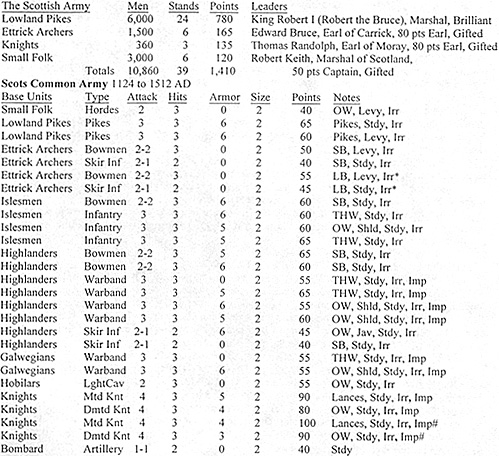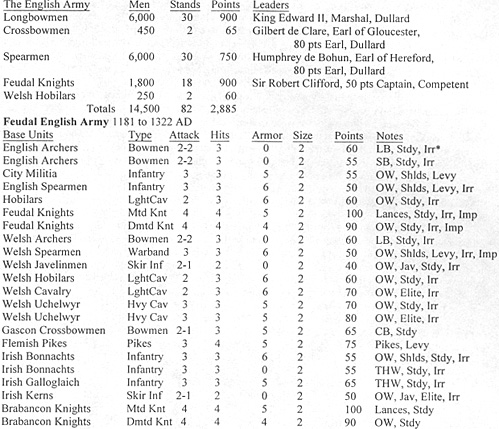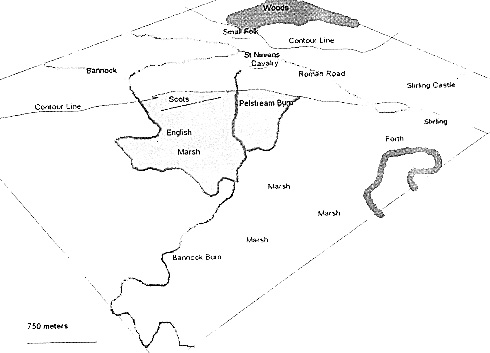"Many English charges were made, and at times it seemed that the Scottish line would break under the fierce attacks of the cavalry. Still there was no penetration of the solid infantry formation."
--"Infantry Warfare in the Early Fourteenth Century," Kelly DeVries
The following are estimates of the strengths of the armies involved. Scottish pikemen normally formed 6 ranks deep. Therefore each stand of pikemen represents about 250 men. Because of their good performance in this battle, the Scottish pikemen should have their usual rating of Levy increased to Steady. Scottish schiltrons (pike formations) may make a half pace move while remaining in a hedgehog formation. As Scottish knights were not as well equipped as their English counterparts they are only given 3 hits per stand.

Infantry stands must outnumber cavalry stands by at least 5:1. Archers may not be over 25% of the infantry stands. Only less than 50% of all infantry stands may have an armor rating of 5 or better. Most Highlanders & Islemen should have an armor rating of 0 or 6.
No longbows may be used until after 1300.
Mounted knights may not have an armor rating of 4 & dismounted knights a rating of 3 until 1400.

Infantry stands must outnumber mounted stands. After 1300 bowmen stands must at least equal other infantry stands.
Longbows were not used in large numbers until after the Baron's War (1260's.) Prior to this time English archers may not have longbows. Welsh archers will always be equipped with longbows, but may not make up more than 20% of the archers in the English army till after 1270.
"O famous race unconquered through the ages, why do you, who used to conquer knights, flee from mere footman? At Berwick, Dunbar, and Falkirk, you carried off the victory, and now you flee from the infantry of the Scots."
-- Vita Edwardi II, Anonymous
King Edward & Clifford should be deployed in front of all other troops with the cavalry. The Gascon crossbows should he deployed on the left, between the English cavalry & spearmen. The longbows should be deployed to the right of the crossbows, in front of the spearmen, & behind the cavalry. The English will have a frontage of about 750 meters (75 cm) on which to deploy their forces. English knights may not dismount for this battle.
Bruce & his forces may be deployed either in a second line behind the first or in the first line between the command of Edward Bruce on the right & Randolph on the left. Edward & Randolph should each be assigned 6 to 8 stands of pikemen with the remainder being assigned to Bruce. The Scottish archers should be divided between Edward & Randolph & should be deployed on the flanks. Keith should be deployed with the Scottish cavalry. If desired then the Scottish forces may be deployed on the hill directly behind the position indicated on the map.
All of the English infantry begin the battle disordered. The English player may not issue any orders to his infantry on the first turn. The Scottish Small Folk may not move until an English unit of knights has lost a melee. The Scottish player will choose who is to have the first move. Each player should deploy his camp within 6 inches of his baseline.
The river Forth is impassable. The Bannock Burn is passable. Units that cross it must stop when reaching it. They will expend all of their movement to cross it & they will be disordered. Both branches of the Pelstream are passable. Any unit that crosses it pays a 10 cm movement penalty & is disordered.
All the land between Bannock Burn & the river Forth is marshland. The land from 100 meters in front of the English line to Bannockburn is also marshland. One may place scattered marshes between the Pelstream Burn & the river Forth. There are two hill lines marked as "Contour Lines" on the map. There is a deep gorge where the Bannock Burn runs across the first contour line into the hills.
Much of the English infantry never became involved in the battle, but instead broke & ran after the English knights were defeated & the Earl of Gloucester killed. To simulate this, only the English knights & or the archer stands should be counted when calculating the English army's break point, though all lost stands & leaders will count against the break point. If the Earl of Gloucester has ordered any knight units to charge, then at the end of the Movement Phase he must be attached to one of the meleeing knight units. The English should be allowed to replace the first two stands of knights lost to archery. (Optional Rule.)
The Scottish army's break point is 17 & the English army's break point is 18. If either Edward II or Robert the Bruce is killed then the battle will end immediately with a loss for the side losing its leader. The battle should be allowed to last for up to 12 turns. If the Scots have not been broken by that time, then it is a Scottish victory.
By 1298 AD both the Scottish & English infantry were regimented into millenaries, or units of 1,000 men, each commanded by a millenar for the English & chiliarch for the Scottish. This was the most significant victory in Scottish history. It was the battle that won Scotland her independence. Below is the map for the battle of Bannockburn. There is a measuring line for reference that is 750 meters. The approximate positions of the two armies on the morning of June 24, 1314 are labeled on the map. The battle began about 3 hours after sunrise & was over by noon. First light was around 3:15 AM.
"Forward brave heart as thou were wont. Douglas will follow thee or die!"
--Said by Sir James the "Black" Douglas as he threw the silver casket containing the heart of Robert Bruce ahead of himself into a melee with the Moors in Spain. Douglas was killed in the battle.
Map

War Cometh Medieval & Fantasy Warfare Rules
Back to MWAN # 127 Table of Contents
Back to MWAN List of Issues
Back to MagWeb Magazine List
© Copyright 2004 Hal Thinglum
This article appears in MagWeb.com (Magazine Web) on the Internet World Wide Web.
Other articles from military history and related magazines are available at http://www.magweb.com